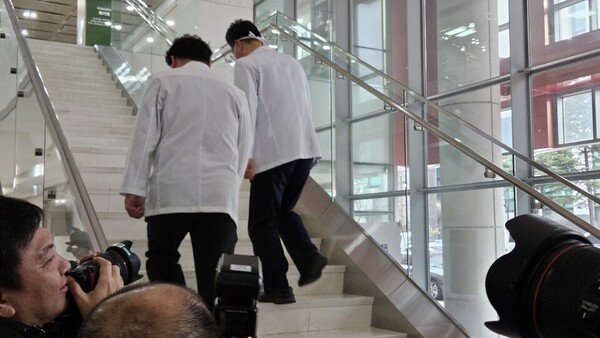Lee Jae-myung, leader of the opposition Democratic Party of Korea, was recovering well from surgery after a knife attack in Busan two days ago, a surgeon who operated on him said on Thursday.
Lee was attacked by a man in his 60s in Gadeokdo, Busan, on Tuesday.
Seoul National University Hospital (SNUH) held a press briefing on the progress of Lee's surgery in Seoul.

Professor Min Seung-kee of the Department of Transplantation and Vascular Surgery, who operated on Lee, and Park Do-joong, head of external affairs at SNUH, conducted the briefing.
SNUH had planned to hold a news conference on Tuesday but could not do so because it required Lee’s consent while Lee was hospitalized in the intensive care unit, the hospital said.
Apparently mindful of some criticism of Lee’s transfer from Busan to Seoul, Professor Min said the decision was made through discussion with the director of the regional trauma center at PNUH, the on-call professor at SNUH’s emergency medical center, and a professor at SNUH’s trauma center.
"At the time, we suspected a neck stab wound and subsequent damage to the internal carotid artery, so we requested a transfer," Min said. "The neck is a complex area with vital organs such as blood vessels, nerves, airways, and the esophagus. Therefore, the significance of the wound lies not in its size, but rather in its depth and location.”
Vascularization of the neck veins and arteries is difficult and requires an experienced vascular surgeon, so SNUH accepted the transfer request from Pusan National University Hospital (PNUH), he explained.
After Lee was transported, Professor Min found that Lee had a 1.4-centimeter stab wound above the sternocleidomastoid muscle on the left side of his neck, and about 60 percent of his internal jugular vein had been sharply severed.
"There was a 1.4cm stab wound above the sternocleidomastoid muscle, which pierced the muscle and severed the artery within the muscle, and there was a large amount of blood pooling. The internal carotid artery, located inside and behind the definition, was intact, and no damage to the surrounding cranial nerves or esophagus/airway was observed," Min said.
As there was a secondary infection risk, Min performed thorough irrigation and primary suturing of the torn saphenous vein to reconstruct the vessel. The stitches were about 9 millimeters.
According to Min, the surgery started at 2:20 p.m. and ended at 6:00 p.m. The surgery team also took measures to prevent blood from pooling at the surgical site. It took two hours for anesthesia and one hour and 40 minutes for surgery.
After a major revascularization procedure, patients are usually treated in the intensive care unit. This is because the surgical site can bleed, blood clots can form, and other complications can occur.
"Lee was transferred to a hospital room the day after the surgery and is recovering now. However, due to the nature of the trauma caused by the knife, there is a risk of further damage, infection, and complications, so we need to monitor his progress," Min said.
Min and Park did not take any questions from reporters, saying they could only speak about the progress of the surgery.


